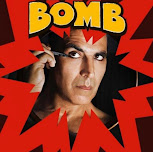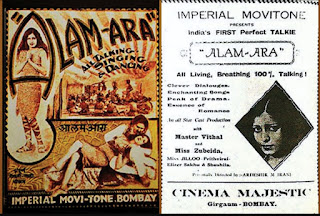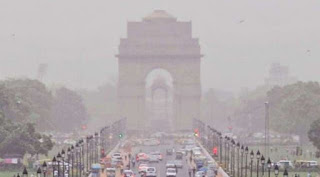Hindi Cinema: The Paradox of Sensibilities
Hindi Cinema: The chase for Message, Money, and
Message-Money
 |
| Laxmmi- The Dud or Bomb |
Indian Cinema:
The Background
Cinema is one of the latest
addition of humanity stream which has spread its reach and impact very
aggressively. Historically various other form of art and culture have been in
existence since ages and have proved their mettle in the eras they were more
relevant. Be it music, dance, plays, painting etc. All these forms had one
thing in common- It was a unidirectional movement. People or more aptly to put
subjects did see, hear or both what was the wish of State. People had limited
or no control on the content they want they wanted to consume.
Consequent to this calibrated
approach these forms were serving unidirectional purpose in favor of ruler and little Impact on Indian Society.
 |
| Raja Harishchandrra: First Motion Picture(1913) |
 |
| Alam-Ara: First Talking Movie(1931) |
To make the journey of Indian Cinema little smooth for our viewers, I have
broken down this saga which has become a 1 billion dollar industry into three Ms
with very different interpretations-
The First M- Message ( 1913-1973)
 |
| Mother India: The Saga |
Post-independence Hindi
Cinema was viewed as a major opinion maker. Pre-1947 era of Indian Cinema
bloomed well under the british patronage. Reflection of which can be witnessed
by the class of audience it managed to make loyal to. This was a pure urban, niche
clientele who were showcased the traditional stage play art-form in much
sophisticated and glamorized style.
This loyalty and class
division was set to vanish in the coming times…and with Independent India this
happened real quickly and movies were
started being looked at not just entertainment perspective but as a medium to
reach masses and impregnate the minds of audiences with the burning yet
pertinent issues of those days. Keeping that in view GOI laid the foundation of “Film and
Television Institute of India” which produced many of the marvels who made
movies which had long lasting impact and influenced a new way of social
thinking.
Jugnu(1947), Do Bigha
Zameen(1953), Devdas(1955); Mother India(1959),Sujata(1959),
Bandini( 1963), Samay Bada Balwan(
1969), Purab Aur Paschim(1972) are few from a list of many.
 |
| Sujata: The Woman |
The craft made in this era
was more hones on its content and delivery. There seems a perfect blend of art
and commerce where people had enough confidence and patience for their labor
with sure expectation that the end result will bear them fruit , if not
in one movie then surely in next or next
after that. The exchange of ideas was fluid and as a result of that
story-line/plot of many movies were taken from regional cinema and vice versa.
The artist of this period used to respect craft of other with grace and
humility. Big reason for this was the the humble background majority came from.
How simple was time can be gauged by the fact that Amitabh Bachchan gave 12
flop films and before his luck would have run out of fuel a miracle did
happen....
The Second M- Money ( 1973-1989)
 |
| Javed-Salim:The Maverick Duo |
“Zanjeer” happened to Big B in 1973, and from here he rarely looked back and became a money minting enterprise. “Zanjeer” was a crime action drama which was written by Salim-Javed (Salim Khan and Javed Akhtar) was loosely based on American movies "Death Rides a Horse" proved to a milestone in career of Salim-Javed which gave them a launchpad with unparallel success. The impact they created in Indian Cinema was unheard of before and after them. Together they worked for 22 projects and all of them were critically and commercially hit. A journey started in Adhikar (1971 ) culminated in 1989 with Mr India.
Movies of this ear were influenced by the greed, power, violence. In
hindsight many believe all 3 evils were a byproduct of the movies made in this
period.
To put the discussion in context, two incidents of at the start of 70s
shaped the path of journey ahead. Mafia and Emergency. The tyrant approach of
the few but mighty people made all things within their reach and at the same
stroke of things made things utterly difficult and in many cases impossible for
majority of Indians. This great divide
created high amount of disconnect and disdain in minds of subservient class.
 |
| Zanjeer: Birth of Angry Young Man |
With no avenue available other than movies they had nowhere to go.. and flock
did they to the cinema halls.. As the surge increased so the content to satiate
their needs and give mental peace. And we see some of the high class action
plots ever imagined like.Other than Big B of today's, few more faces were adored
by the masses like Dharmendra, Vinod Khanna, Rajnikant, Jitendra.
While this Action masala genre was minting money, simultaneously a parallelart of cinema was taking concrete steps which had Satyajit Ray as its
inspiration. The famous term coined for this style was New World Cinema. Few
credible names in this forte were Mrinal Sen, Shyam Benegal,Govind Nihalni,
Kundan Shah, Mahesh Bhatt. With movies like Ankur(1974), Arth (1982), Tamas(1988),
Jaane Bhi Do Yaaro(1988). But like what happens with the very best of
creations, the inevitable happened with these masters as well.. Slowly and
gradually they started venturing into a risky place- either they also tried
making money by doing cheap shady work or their movies started dreaming of too
idealistic world and smelled more of left liberal odor.
SO this era of Money managed to infiltrate in many virgin territories and
managed to capture new market for Indian Hindi Cinema. Two big names left fine
footprints in motion picture landscape and were conferred as showman of Hindi
Cinema- Raj Kapoor , Subhash Ghai with movies like- Ram Teri Ganga Maili(
1985), Prem Rog(1982); Karz(1980), Karma(1986)..
The Third M- Message-Money ( 1990-Present )
Third and current phase of India Cinema kick started in the last decade of
the twenth century. This phase not only consolidated the stride made in Phase
two on Money front but also relived the glory of Phase one in the field of Message
delivery on social topics. Many projects of this era invetsed in demolishing
the age old ill practices in society while few explored the uncharted virgin
territories and initiated a new conversation on topics of social stigma. First
release came in the form of Ghayal(1990) a potboiler where the
antagonist fights for his rights and had with solid, so-real
dialogue delivery.
 |
| Ghayal: Sunny Deol |
This generation of cinema had neither dearth of money nor ideas, more importantly one things which was found in abundance: Appetite for risk take which has completed vanished in second half of phase two. Indian Economy opening and demolishing of License Raj in 1991 made a huge impact in lives of common people. Lot of sectors with restricted entry for private enterprises, all of sudden became an opportunity to thrive. This new energy of promoting the business had many cascading effects as this gifted two things to modern India- New employment opportunities which were potent mixtures of capitalist ideology, a far departure from Social fabric and spurred a competitive eco system. In this game people started making money purely basis the skill and hard work they put in; and the hungry yet talented middle class reaped the benefit and started making good money. More money in hand, made people ever more hungry to attain higher scales. This essentially made people start dreaming big, be a leader rather than just followers.
This new
found aspiration started reflecting in the contemporary cinema of 90s where
themes started galvanizing towards solution oriented instead of raising
questions. And with the scale of movie making improved, technology started
playing a major role in cinema which made the content reaching and appealing to
many newer markets. This is the time where the famous “BOLLYWOOD” term came in practice.
Sharing
few movies who made mark both in Commercial as well as Serious cinema here,
though the list is endless and making job tuff to pick few as my favorite. To
be fair in my judgement breaking down these two decades in equal sets-
 |
| Damini:The Crusader |
 |
| Uri: The Saga |
 |
| Parineeta- The Bengal Saga |
Part1 1990-1999
Prahaar: The Final Attack (1991), Baazigar (1993), Daminini (1993), Maachis
(1996), Fire (1996).
Part2 2000-2009
Haasil ( 2003 ), Lakshya ( 2004), Parineeta ( 2005), Page 3 (2005), Aamir
( 2008).
Part3 2010-Laxmmi Bomb
Peepli [Live] (2010), Delhi Belly ( 2011), Dil Dhadakne Do ( 2015), Toilet:
Ek Prem Katha ( 2017), Uri: The Surgical Strike ( 2019).
Current Heartthrob of Bollywood Akshay Kumar, who is the safest bet any businessman would like to work with has become the mascot of this era of Money & Message. Incidentally his debut film Saugandh was released in 1991. His new image of actor with impact took flight since 2013 with the release of Special 26.
From
there he never looked back and has been dishing out movies after movies and
almost all of them has made handsome money for the financiers. Baby (2015),
Rustom ( 2016), Naam Shabana ( 2017), Gold ( 2018), Padman
(2018), Mission Mangal ( 2019). Due to the choice of projects he has
been doing which are highly successful as well, he has been fondly called now Manoj
Bharat Kumar, which is a reference with 1970s star with ultranationalist projects
– Manoj Kumar!
But it appears, now he has also fallen into a trap of image makeover by being completely invisible during the “Nepotism in Bollywood” debate and appeared in social media like a shameless clown just before the theatrical release of his movie “Laxmmi Bomb”.
What is social contribution of Bollywood, to the younger Indian masses is another pertinent discussion worth its salt...
A Carefully, deceitfully crafted image exposed in broad daylight will crack his empire?... November 2020 will unravel!! Trishanku(त्रिशंकु)…


Comments
Post a Comment